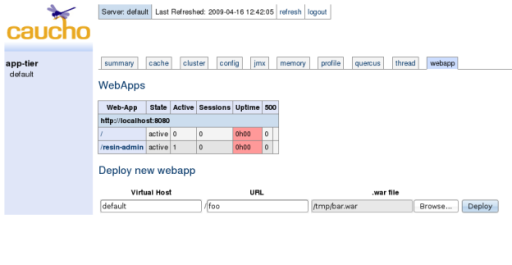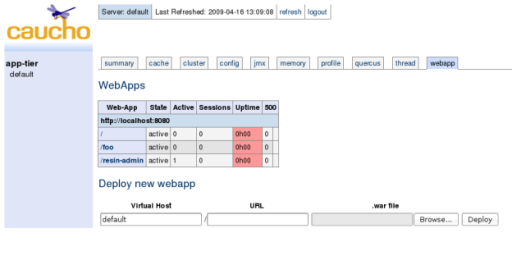
packaging/deployment
| database | .git overview |
Resin provides a wide variety of custom packaging and deployment options.
In this scenario, you want to configure a web-app with a specific root-directory and specify the location of the .war file. As usual, when Resin sees any changes in the .war file, it will expand the new data into the root-directory and restart the web-app. This capability, gives sites more flexibility where their directories and archive files should be placed, beyond the standard webapps directory.
The optional archive-path argument of the
<web-app> will point to the .war file to be expanded.
| ATTRIBUTE | DESCRIPTION | DEFAULT |
|---|---|---|
| archive-path | path to the .war file which contains the web-app's contents | |
| dependency-check-interval | how often Resin should check for changes in the web-app for a redeployment | 2s |
| id | unique identifier for the web-app and the default context-path value | |
| redeploy-check-interval | how often Resin should check the .war file for changes | 60s |
| redeploy-mode | how Resin should handle redeployment: automatic, lazy, or manual | automatic |
| root-directory | path to the expanded web-app directory | as a sub-directory of the virtual-hosts's root |
<resin xmlns="http://caucho.com/ns/resin">
<cluster id="">
<host id="">
<web-app id="/foo" root-directory="/var/www/foo"
archive-path="/usr/local/stage/foo.war"/>
</host>
</cluster>
</resin>
The startup-mode is used in a number of places to determine the behaviour of a resource when the server starts.
The startup-mode has three values: "automatic", "lazy", and "manual".
- automatic - starts the resource on server start (default)
- lazy - starts the resource on the first use
- manual - waits for JMX to start the resource
The redeploy-mode is used in a number of places to determine the behaviour of a resource when it is replaced or modified while the server is running.
The redeploy-mode has two values: "automatic", and "manual".
- automatic - restarts the resource when it is modified (web.xml, *.class, *.war, etc).
- manual - waits for JMX to restart the resource when changes occur.
Resin can deploy multiple versions of a web-app simultaneously, simplifying any application upgrades. The old version of the web-app will continue to receive old sessions, while the new version will get the new requests. So any user will see a consistent version as the web site update occurs with no downtime required.
The versioning requires <web-app-deploy>, i.e. it works with the webapps directory. The versioning is numerically-based, allowing dotted notation, to determine the most recent version. A simple deployment process might use to upgrade from . A more complicated one might use to upgrade from .
The attribute of the <web-app-deploy> enables versioning:
<resin xmlns="http://caucho.com/ns/resin"> <cluster id=""> <host id=""> <web-app-deploy path="webapps" versioning="true"/> </host> </cluster> </resin>
It may be possible to deploy a web application to a live server without interruption to service if certain conditions are met.
- The session objects for your users are being persisted.
- The usage of session scoped objects between the old version and the new is compatible.
- The usage of application scoped objects between the old version and the new is compatible.
- Database schema changes are not required.
Resin allows you to have a backup instance running. The idea is that this backup instance of Resin takes over if your primary Resin instance goes down.
If you are using a load balancer to distribute your load to multiple primary servers, each primary server has a backup server.
You can use this feature to deploy to a live server without interruption of service.
- shutdown primary server(s) (backup server(s) takes over)
- deploy new war to primary server(s)
- start primary server(s). As soon as the primary server starts, the user will be using the new version of the application.
- deploy new war to backup server(s)
As of Resin 4.0.0, it is now possible to deploy web applications remotely to a shared repository that is distributed across the cluster. This feature allows you to deploy once to any triad server and have the application be updated automatically across the entire cluster. When a new dynamic server joins the cluster, the triad will populate it with these applications as well.
To deploy an application remotely:
- log into the resin-admin console on any triad server. Make sure you are connecting over SSL, as this feature is not available over a non-encrypted channel.
- Browse to the "webapp" tab of the resin-admin server and at the bottom
of the page, enter the virtual host, URL, and local .war file specifying
the web application, then press "Deploy".

-
The application should now be deployed on the server. In a few moments,
all the servers in the cluster will have the webapp.

Command line deployment capabilities were introduced in Resin 4.0.14. The set of commands allows deploying, undeploying, listing applications deployed on the server and controlling application lifecycle.
Synopsis of the provided commands and options
| COMMAND | DESCRIPTION |
|---|---|
| deploy | deploys an application archive |
| undeploy | un-deploys an application specified by a context |
| deploy-list | lists all applications deployed on a server |
| deploy-copy | copies an application from one context to another |
| start-webapp | starts web application context |
| stop-webapp | stops web application context |
| restart-webapp | restarts web application context |
| ARGUMENT | MEANING | DEFAULT |
|---|---|---|
| -conf | configuration file | conf/resin.xml |
| -address | ip or host name of the server | taken from conf/resin.xml |
| -port | server http port | taken from conf/resin.xml |
| -user | user name used for authentication to the server | none, required |
| -password | password used for authentication to the server | none, required |
| -m | commit message | none, optional |
deploying application
Deploying an application is done with a deploy command
java -jar resin.jar [-conf <file>] deploy -user <user> -password <password> [options] <war-file>
java -jar lib/resin.jar deploy -user admin -password secret /projects/hello-world/hello-world.war Deployed production/webapp/default/hello-world as hello-world.war to http://127.0.0.1:8080/hmtp
| ARGUMENT | MEANING | DEFAULT |
|---|---|---|
| -host | virtual host to make application available on | default |
| -name | name of the context to deploy to, defaults to war-file name | [/foo].war |
| -stage | specifies stage for staging an application | production |
| -version | version of application formatted as <major.minor.micro.qualifier> | none |
listing deployed applications
Listing deployed applications is done with a deploy-list command
java -jar resin.jar [-conf <file>] deploy-list -user <user> -password <password>
java -jar lib/resin.jar deploy-list -user admin -password secret
production/webapp/default/hello-worldcopy application from context '/hello-world' to context '/foo'
Copying an applicaiton is done with a deploy-copy command
java -jar resin.jar [-conf <file>] deploy-copy -user <user> -password <password> [options]
java -jar lib/resin.jar deploy-copy -user admin -password secret -source hello-world -target foo copied production/webapp/default/hello-world to production/webapp/default/foo
| ARGUMENT | MEANING | DEFAULT |
|---|---|---|
| -source | context to copy application from | none |
| -source host | host to copy application from | default |
| -source-stage | source stage | production |
| -source-version | version of the source application formatted as <major.minor.micro.qualifier> | none |
| -target | context to copy application to | none |
| -target-host | host to copy an application to | default |
| -target-stage | target stage | production |
| -target-version | version application to use for a target, formatted as <major.minor.micro.qualifier> | none |
undeploying application
Undeploying an application is done with an undeploy command
java -jar lib/resin.jar [-conf <file>] undeploy -user <user> -password <password> [options] <name>
java -jar lib/resin.jar undeploy -user admin -password secret undeploy foo Undeployed foo from http://127.0.0.1:8080/hmtp
| ARGUMENT | MEANING | DEFAULT |
|---|---|---|
| -host | virtual host to make application available on | default |
| -stage | specifies stage for staging an application | production |
| -version | version of application formatted as <major.minor.micro.qualifier> | none |
starting application
Starting an application is done with an start-webapp command
java -jar resin.jar [-conf <file>] start-webapp -user <user> -password <password> [options] <name>
java -jar lib/resin.jar start-webapp -user admin -password secret foo 'production/webapp/default/foo' is started
| ARGUMENT | MEANING | DEFAULT |
|---|---|---|
| -host | virtual host to make application available on | default |
| -stage | specifies stage for staging an application | production |
| -version | version of application formatted as <major.minor.micro.qualifier> | none |
stopping application
Stopping an application is done with an stop-webapp command
java -jar resin.jar [-conf <file>] stop-webapp -user <user> -password <password> [options] <name>
java -jar lib/resin.jar stop-webapp -user admin -password secret foo 'production/webapp/default/foo' is stopped
| ARGUMENT | MEANING | DEFAULT |
|---|---|---|
| -host | virtual host to make application available on | default |
| -stage | specifies stage for staging an application | production |
| -version | version of application formatted as <major.minor.micro.qualifier> | none |
restarting application
Restarting an application is done with an restart-webapp command
java -jar resin.jar [-conf <file>] restart-webapp -user <user> -password <password> [options] <name>
java -jar lib/resin.jar restart-webapp -user admin -password secret foo 'production/webapp/default/foo' is restarted
| ARGUMENT | MEANING | DEFAULT |
|---|---|---|
| -host | virtual host to make application available on | default |
| -stage | specifies stage for staging an application | production |
| -version | version of application formatted as <major.minor.micro.qualifier> | none |
With remote deployment, you can use an ant or maven task to deploy a .war file to a running Resin instance. This will require some configuration of the resin.xml to enable deployment. For security reasons, remote deployment and administration is disabled by default, so you will need to enable the features to use them.
- Enable remote administration (the HMTP service).
- Add at least one admin user in AdminAuthenticator.
- Enable the remote deploy service.
The first step is enabling remote administration, so you can manage the server remotely, either with eclipse, or ant, or maven. If disabled, Resin will ignore all remote administration requests. The disabled error message will be something like "Failed to connect to HMTP because HMTP service has not been enabled." In the resin.xml, the <resin:RemoteAdminService> tag enables remote administration:
<resin xmlns="http://caucho.com/ns/resin"
xmlns:resin="urn:java:com.caucho.resin">
...
<resin:AdminAuthenticator>
<resin:user name="harry" password="..."/>
</resin:AdminAuthenticator>
<cluster id="">
<resin:RemoteAdminService/>
<resin:DeployService/>
...
</cluster>
</resin>
The second step is adding at least one administration user, so only authorized administrators can update the server. The <resin:AdminAuthenticator> tag configures administrators. If no administrators are added, Resin will reject any remote administration requests.
The third step is enabling the deploy service itself with the <resin:DeployService> tag. The deploy service is responsible for managing uploads of new applications and distributing them to the servers in the cluster.
When troubleshooting, it's helpful to know that Resin uses BAM/HMTP to connect the deployment client with the deployment server. The <resin:RemoteAdminService> enables BAM/HMTP. If the server is down or the remote admin service isn't enabled, the error messages will complain that the BAM/HMTP connection is not allowed.
| database | .git overview |
| Copyright © 1998-2011 Caucho Technology, Inc. All rights reserved. Resin ® is a registered trademark, and Quercustm, Ambertm, and Hessiantm are trademarks of Caucho Technology. |